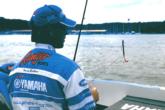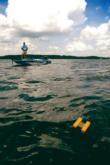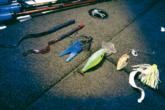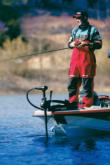Electric bass
When the water starts to move, it turns bass on like a light switch

Yamaha pro Terry Bolton of Paducah, Ky., strives to keep current with bass on lakes that have power-generating dams, such as the many reservoirs along the Cumberland, Tennessee and Coosa rivers. Power generation sucks water from a reservoir like a bathtub drain. This creates currents that put bass on the feed, especially after the fish move to their summer digs on the main lake.
Time it right and you can load up on quality bass, as Bolton did when he fished a June EverStart Series event on Kentucky Lake in 1998. At that event, Bolton found bass relating to the downstream point of a creek channel where it joined the Tennessee River channel. The juncture yielded nearly 17 pounds of bass to Bolton on opening day thanks to moving water caused by power generation.
As Bolton raced to his sweet spot the second morning, he could see a strong current sweeping past the lake’s navigation buoys. The sight made his blood run electric.
 When he finally reached his destination, Bolton positioned his boat over the Tennessee River channel and dragged a 10 1/2-inch worm over the downstream creek-channel point. In 30 minutes, he stuffed his livewell with nearly 19 pounds of largemouths.
When he finally reached his destination, Bolton positioned his boat over the Tennessee River channel and dragged a 10 1/2-inch worm over the downstream creek-channel point. In 30 minutes, he stuffed his livewell with nearly 19 pounds of largemouths.
Though rising water and reduced current flows hampered the bite during the remaining days of the tournament, Bolton milked two more limits from the channel point and claimed second place.
Current times
Power generation helps Bolton stay in touch with bass from late May through September. The fishing is hottest in May and June, but July and August give up bigger bass. The bite is generally more consistent throughout the day in September because many reservoirs are being drawn down to winter pool, which keeps the current moving.
“The power-generation schedule can change from day to day,” Bolton said. “Sometimes it runs all night and shuts down by 9 a.m. On other days, the water may be slack early and suddenly start flowing at 10 or 11 a.m.”
To insure that he taps into peak feeding times, Bolton contacts the Corps of Engineers the night before he goes fishing to learn the power-generating schedule for the next day.
“You can catch bass from main-lake structures when the dam isn’t pulling water, but you’ll catch 10 times as many when the current kicks in,” Bolton said. “When the water starts to move, it turns bass on like a light switch.”
Current structures
 Any structure near a river or creek-channel ledge is a potential hot spot for current bass. Humps, points and channel junctures produce especially well for Bolton. Bass always face into the current, and they usually gang up along upstream edges. These facts dictate Bolton’s boat position and casting angle.
Any structure near a river or creek-channel ledge is a potential hot spot for current bass. Humps, points and channel junctures produce especially well for Bolton. Bass always face into the current, and they usually gang up along upstream edges. These facts dictate Bolton’s boat position and casting angle.
With channel junctures, Bolton concentrates on the downstream point of the creek channel where it joins the main river channel. He positions his boat facing upstream over the deeper river channel. Then he retrieves his lures over the leading edge of the downstream creek-channel point.
“You have to compensate for the current,” Bolton said. “If you cast over the point, the current will blow your bait downstream and you end up fishing behind the bass.”
Bolton drops a marker buoy on the end of the downstream creek-channel point and moves his boat up the river channel until his outboard is even with the buoy. Then he casts into the middle of the creek channel. By the time his bait gets to the bottom, the current has pushed it to the leading edge of the point.
“When I’m fishing channel junctures, my boat is typically sitting over 20 or more feet of water,” Bolton said. “I catch bass on the point anywhere from 5 to 17 feet deep.”
Current baits
Worms: Zoom’s 10 1/2-inch Ole Monster and 7 1/2-inch Magnum worms in plum are Bolton’s primary  soft baits for moving-water bass. A 3/8-ounce bullet sinker and thin-diameter 12-pound Stren High Impact line get the worms deep quickly and reduce the current’s influence. Bolton works the worms with a “controlled” lift-drop retrieve that does not pull them too high off bottom.
soft baits for moving-water bass. A 3/8-ounce bullet sinker and thin-diameter 12-pound Stren High Impact line get the worms deep quickly and reduce the current’s influence. Bolton works the worms with a “controlled” lift-drop retrieve that does not pull them too high off bottom.
“I fish the 10 1/2-inch worm from May through about the middle of July,” Bolton said. “Big bass like that big bait.”
From late July on, Bolton relies mainly on the 7 1/2-inch Magnum. It drops faster than the larger worm and sparks reaction strikes.
Jigs: A black and brown 1/2-ounce Stanley casting jig is a big player when Bolton fishes current. It has the right sink rate to maintain bottom contact and trigger strikes, and its thin hook penetrates with less force, which helps overcome slack in the line. Bolton ties traditional rubber skirts to his Stanley jigs because he believes they show bass more bulk, action and a better silhouette. He tips his jigs with a sapphire Zoom Small Salty Chunk.
“In May and June, bass tend to hold higher off the bottom and feed on shad,” Bolton said. “I have my best luck then ripping the jig off bottom with a high hop and letting it drop back on a slack line.”
Later in the summer, bass hold tighter to stumps, brush and other cover on the bottom. Then Bolton works a jig with short hops to keep it down and improve his odds for contacting cover.
Crank and wind baits: Bolton puts Luhr Jensen’s 3/4-ounce Hot Lips crankbait to work in early summer. The lure digs 16 to 17 feet deep on 12-pound line, which is sufficient in most situations. To maintain bottom contact in the strike zone, Bolton often moves closer to structures when casting crankbaits than with other lures.
A 3/4-ounce Stanley double-willow spinnerbait in chartreuse and white also catches early summer bass for Bolton. He favors No. 3 and No. 5 gold blades and nabs spinnerbait bass 5 to 18 feet deep.
“I let the spinnerbait sink to the bottom, and then I keep it swimming 1 to 2 feet above the bottom with occasional contact,” Bolton said. “I use a slow-roll retrieve most of the time. Sometimes I’ll give it a pumping action. When the bait falls off a ledge, I hesitate and let it drop.”
Near shore current
 Stratos pro Craig Powers of Rockwood, Tenn., a regular on the Wal-Mart FLW Tour, often finds current-related bass close to shore. When the current flows, Powers heads for rocky bluff walls on the main lake. Here he catches heavy largemouths, smallmouths and spotted bass by flipping a white 1- to 1 1/4-ounce bass jig to rock walls and letting the lure swim pendulum-fashion back to the boat.
Stratos pro Craig Powers of Rockwood, Tenn., a regular on the Wal-Mart FLW Tour, often finds current-related bass close to shore. When the current flows, Powers heads for rocky bluff walls on the main lake. Here he catches heavy largemouths, smallmouths and spotted bass by flipping a white 1- to 1 1/4-ounce bass jig to rock walls and letting the lure swim pendulum-fashion back to the boat.
“I’m flipping the jig right against the bank, but my boat is sitting over 20 to 40 feet of water,” Powers said.
When the heavy jig plummets, any bass hugging the wall has to decide instantly whether to strike. The snap decision often goes in Powers’ favor.
“You really don’t need to work the jig,” Powers said. “I run my electric motor on a high speed into the current. After I flip, I hold my rod still. By the time the jig swings back to the boat, it’s about even with the outboard. Almost every strike comes when I start to lift the bait.”
Bluff walls came through for Powers when he fished an August Wal-Mart Bass Fishing League tournament on Fort Loudoun Lake in 1996. The current flowed through the reservoir throughout the day, which allowed Powers to bag a heavy limit of largemouths, including one weighing more than 7 pounds, from a bluff wall up the lake. The big bass came at high noon.
On the way back to the weigh-in, Powers stopped at another bluff wall closer to the dam. With only 10 minutes left to fish, he snatched a smallmouth weighing more than 6 pounds with his heavy white jig. The big smallie pushed his limit to 21 pounds, 13 ounces, good enough for first place.
Shallow cover
Main-lake structures and bluff walls are not the only places power-generated currents work to your advantage. Craig Powers claims that any bank cover brushed by flowing water is likely to give up bass, even cover in the shallows.
“I catch a lot of bass from blowdowns on the main lake when the water moves,” Powers said. “Bass tuck behind the limbs to get out of the current and ambush whatever gets washed to them.”
Powers casts upstream and swims his baits along the limbs. In shallow water, he opts for a 1/2-ounce Predator double-willow spinnerbait and a wide-wobbling crankbait that runs 1 to 2 feet deep. The bass usually hold on the ends of fallen trees or inside the limbs.